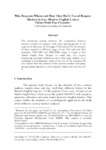Who Requests Whom and How They Do It: Use of Request Markers in Late Modern English Letters

View/
Use this link to cite
http://hdl.handle.net/2183/17041Collections
Metadata
Show full item recordTitle
Who Requests Whom and How They Do It: Use of Request Markers in Late Modern English LettersAuthor(s)
Date
2008Citation
AEDEAN 2008, 31: 269-278 ISBN-978-84-9749-278-2
Abstract
[Abstract] The nineteenth century witnesses the competition between courtesy markers in requests, with please gaining ground at the expense of older pray. In this paper I will account for the situation of these markers in different stages of the 19th and early 20th centuries: 1860-1889 and 1890-1919, using A Corpus of Late Modern English Prose. Despite its small size, this corpus, comprising epistolary collections and a diary part, enables us to undertake a sociolinguistic study of the use of the markers. We can explore how the renewal of the courtesy marker took place, paying special attention to who requests whom and how they do it.
ISBN
978-84-9749-278-2





